Untitled - Journal of Lighting Engineering
Untitled - Journal of Lighting Engineering
Untitled - Journal of Lighting Engineering
Create successful ePaper yourself
Turn your PDF publications into a flip-book with our unique Google optimized e-Paper software.
have been used for few years mostly for<br />
façade lighting or architainment<br />
(architectural entertaining lighting) with the<br />
scope <strong>of</strong> projecting non-white effects, the<br />
tunable sources are used to display various<br />
white color temperatures to suit the<br />
occasion. Research has shown that different<br />
colors <strong>of</strong> light affect more than just our<br />
conscious vision system. The newly<br />
discovered intrinsically photosensitive<br />
retinal ganglion cells (ipRGC) in our eyes<br />
respond to blue light by suppressing<br />
production <strong>of</strong> sleep-inducing melatonin, so<br />
the naturally blue-rich light <strong>of</strong> daytime<br />
keeps us alert, while reddish evening light<br />
lets us ease into sleep. With LEDs it would<br />
be possible to adapt light color for different<br />
activities such as alertness, which in turn<br />
can affect circadian rhythm positively.<br />
The controllability <strong>of</strong> LED light color,<br />
intensity and direction allows novel lighting<br />
system designs that can deliver a wide<br />
range <strong>of</strong> social benefits. In schools, for<br />
example, an LED lighting system with three<br />
color/intensity settings (red-rich "relax",<br />
blue-infused "energy", yellowish-mild<br />
"concentrate") has been shown to<br />
dramatically improve student performance.<br />
NASA is developing similar lights for the<br />
International Space Station because<br />
astronauts have trouble sleeping more than<br />
6 hours a night. The lights will switch from<br />
blue-rich to keep the astronauts alert during<br />
their working day to red-rich light when<br />
they are relaxing before bed. Just recently,<br />
Philips and Apple launched the Hue bulb,<br />
which can be tuned using smartphones or<br />
tablet computers to provide any desired<br />
light color or white CCT using RBG LEDs.<br />
• Integral Controls – the example <strong>of</strong><br />
the Hue bulb is the best example <strong>of</strong> how<br />
Information<br />
controls could actually change the old<br />
lighting (lamp-switch) paradigm. Wired or<br />
wireless but for sure digital, controls can<br />
now co-exist in synergy with the SSLs and<br />
be the motor not an afterthought <strong>of</strong> the<br />
lighting design, adapting dynamically for<br />
convenience. Diming drivers cost a fraction<br />
<strong>of</strong> the fluorescent or HID diming electronic<br />
ballasts and will become a default feature,<br />
while the miniaturization <strong>of</strong> sensors will<br />
economically enable their integrations with<br />
LED luminaires. In a not-so distant future<br />
(SSL) lights will comprise a complex<br />
communication network where sensors and<br />
controls join forces to maximize<br />
convenience, safety and save energy,<br />
resulting in such features as road lights that<br />
brighten when a fire engine approaches and<br />
interior lights that react in a similar fashion<br />
when someone enters the building.<br />
Cristian ŞUVĂGĂU<br />
Dr., P.Eng., LC, CEM,<br />
MIES, MCIE<br />
BC Hydro PowerSmart,<br />
Burnaby, BC, V5H4TB<br />
Canada<br />
e-mail: cristian.suvagau@bchydro.com<br />
Cristian holds a Ph.D. from the Technical<br />
University <strong>of</strong> Construction in Bucharest,<br />
Romania. He has been practicing and<br />
teaching architectural lighting design and<br />
energy efficiency in Europe and North<br />
America for over 25 years. He is also a<br />
member <strong>of</strong> the Canadian NC <strong>of</strong> the CIE and<br />
Past President <strong>of</strong> the BC chapter <strong>of</strong> IESNA.<br />
70 Ingineria Iluminatului 2012; 14, 2: 67-70
















